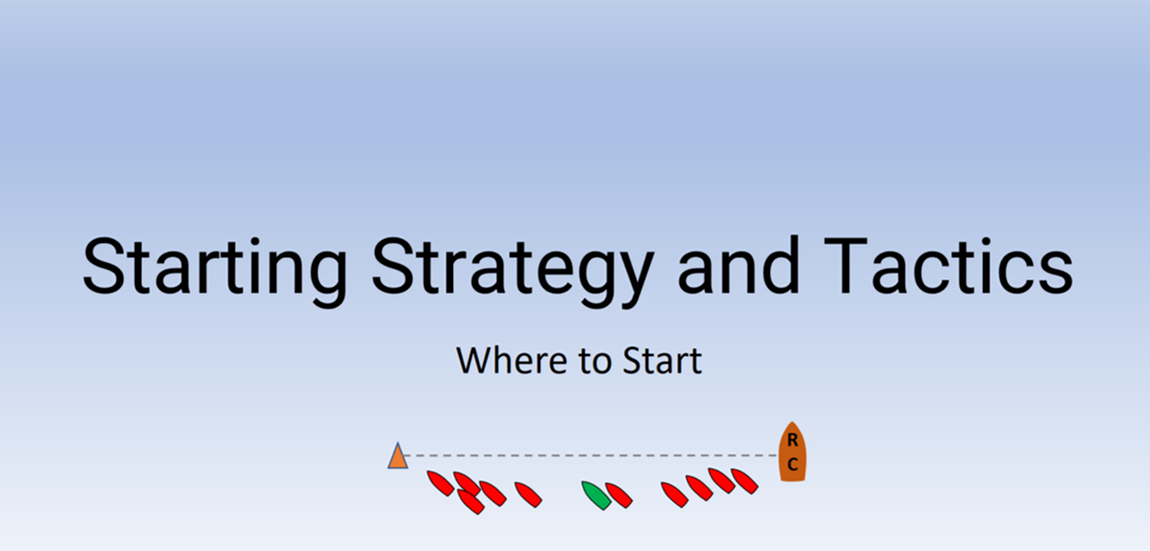This post covers the expert wisdom on where to start. We updated the post from the original version, incorporating some new key points and adding a video from Roble/Shea Sailing on the topic.
Where to Start – A Balancing Act
In deciding where to start, you must balance some potentially competing factors.
- Line set and advantage
- First beat strategy
- Managing risk
Line Set and Advantage
Check if line is square to the wind
- Go head to wind – your bow will point to the upwind end.
- Sail along the line in both directions – you will sail more close-hauled when sailing to the upwind end.
- Check the flag on the RC boat – front of the flag points to upwind end.
How much is the advantage?
- At 5 degrees, advantage is 9′ per 100′ of line.
- At 10 degrees, advantage is 17′ per 100′ of line.
- In shifty winds, any advantage is reduced. since boats lose or gain in shifts based on position.
First Beat Strategy
- One side of the course is preferred: start on that side of the line.
- Oscillating breeze: try to get to the first shift before others do.
- Lots of changes in velocity: try to get to the first puff before others.
- If you’re not sure, or if many of these factors are present, the middle is always a good place to start.
- If the course is narrow, think about how far you can sail without running out of room.
Manage Risk
Risks to avoid
- Avoid crowds. Most experts advise dividing the line into thirds. If the left is favored, but there’s a big crowd, start in the left third of the line, just to the right of the crowd.
- Another big risk is not being able to tack. If your strategy requires freedom to tack, don’t start with a big crowd on your right.
- Think about staying away from competitors that might be faster, or that tend to pinch or cause other problems.
Ends and Middle
- Pin
- The big advantage of starting at the pin is getting clear air to leeward – but only if you win that end.
- You can also look at the eyes of the RC person judging the line to tell when you’re on the line.
- There are big risks, and some experts advise against trying to win the pin end.
- First, you can easily get shut out and have to jibe around.
- Also, you may be unable to tack, which might be a huge problem.
- Committee Boat
- Often crowded, and you have the chance of fouling someone.
- Easier to judge the line, and if you are over early, you can do a quick turn and start again.
- If you get buried, a quick tack to port will put you in clear air.
- Middle
- A lot of sailors try to start near the ends, so the middle may be less crowded.
- The middle is often the least risky place strategically, since you can observe progress in the first few minutes and head to the side that’s working. This especially helpful in a big fleet.
- Sailors in the middle of the line tend to hang back, creating a mid-line sag. If you get a good line sight, you can take advantage of this and get your bow out in front.
- If you’re over early, you have a long way to go, probably in traffic, to sail around the end of the line.
- In light winds, the air is more disturbed in the middle, and you can get better air on the ends of the line.
Video: Where to Start with Roble / Shea Sailing
In this video excerpt from the ILYA Fast Forward Series, olympic qualifiers Steph Roble and Maggie Shea discuss their approach to deciding where to start.
Summary
Often, these factors are competing and you have to decide how to balance them. Their relative importance changes.
- Line set may be more important with a large angle or long line.
- First beat strategy may be more important if it is critical that you:
- Get to a side
- Have freedom to tack
- Find more wind
- Managing risk may be more important:
- In a big fleet
- If you need to sail conservatively
- If you lack confidence in your starting ability
Related Content:
Race Start Strategy with Peter Isler (first 9:35 discusses where to start)
Starting Line – Accelerating and Clear Air
Starting: ILYA Fast Forward Seminar
Sailors Helping Sailors
Will you share your knowledge with your related Comments below?


